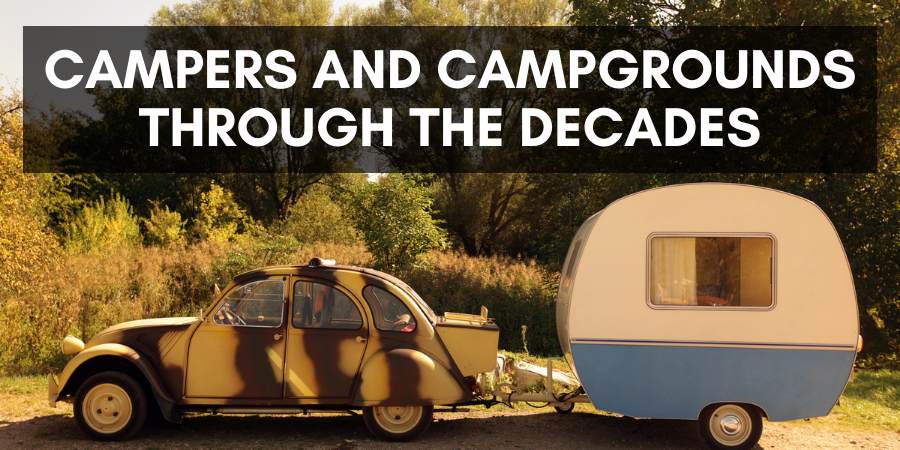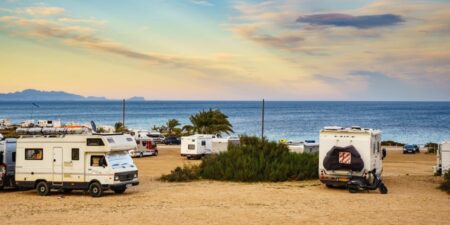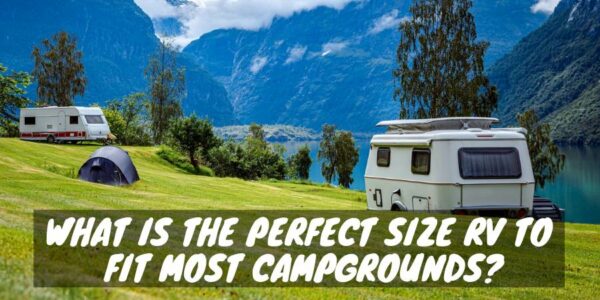RVing is currently breaking records for sales and campground bookings, with singles, couples, and families hitting the road for safer, less expensive, and more adventurous vacations.
But what is the history of RVs? When was the first camper built, and when did campgrounds start catering to people who own recreational vehicles?
As a full-time RVer, I have little knowledge of its origins. So, I put together a comprehensive look at RVs and campground changes throughout the decades to learn more.
Please read along and enjoy some fascinating details on the evolution of the RV and campground industry!
When Was the First Motorized Recreational Vehicle Made?
Surprisingly, the first RVs were built not long after the first automobiles hit the market in the early 1900s.
Most of the early recreational vehicles were DIY alterations to a car for a more protected place to sleep, store supplies, or wash up, versus tent camping.
The first official recreational vehicle on record was made in 1910 by Pierce-Arrow and was called the Touring Landau. As the first “motorhome,” it had a rear seat that folded down into a bed and a front seat that opened to reveal a sink and chamber pot toilet.
Early camping trailer manufacturing also began around 1910, with companies such as Auto-Kamp Trailers and the Los Angeles Trailer Works leading the way.
These “auto campers” were small single-axle trailers that opened much like a pop-up, but the walls were completely canvas with the look of a large tent. Inside, the Auto-Kamp brand includes these features:
- Two fold-out beds with spring mattresses
- Kitchen outfit
- Two-burner gasoline stove
- Ice-box storage
- Fold-up dinette table
- Electric lights
For all that, the price tag on the first models was between $150-$200.
In 1915, Anheuser-Busch made the Lamsteed Kampkar on a Model T Ford chassis for the price of $535.
However, the RV industry slowly grew in the early days as roads weren’t as extensive and easy to traverse as they would become in future decades.
What kept the interest in RVing rising was the popularity of National Parks during this time, giving guests a new way to travel and camp.
As for campgrounds, owners did little to alter the spaces already established for tent camping aside from providing a more dedicated area for car and “touring car” camping, as you can see in this 1915 photo of a state park in Michigan.
In 1919, the Tin Can Tourists became the country’s first camping club, with the inaugural rally held in Florida.
RV and Campground Evolution During the 1920s
As demand through the 1920s grew for more places to stay in a recreational vehicle, new RV parks and campgrounds began to pop up across the US.
Campgrounds already in operation began to expand the number of campsites available to guests, along with upgrades to the park’s amenities.
According to David Woolworth, a vintage RV collector, you could stay in a Denver campground during the early 1920s, where guests could pick from 800 campsites. Once you set up camp, you could enjoy the park’s nine-hole golf course, get your hair done at the salon, do laundry, go grocery shopping, and catch a movie at the 400-seat theater.
1920’s Vintage Homebuilt Travel Trailer Tour (Video)
RV and Campground Changes in the 1930s
Things began picking up in the RV industry this decade as the country lifted itself out of the Great Depression.
The Tennessee Traveler Housecar was one motorhome, similar in size and design to a small Class C, produced in 1931 on a Model AA Ford chassis. The boxy design makes the most of the interior headroom and living space, with many other RV manufacturers offering the same style and exterior look.
The Tennessee Traveler features residential-style wood cabinetry with a clever drop-down wall that becomes a kitchen countertop and exposes more storage space.
The rear couch becomes a bed, and the camper offers heat. The main driver and passenger seats are wood, with full-size access doors on both sides of the RV.
For travel trailers in this decade, most ranged from 16 to 20 feet long and were 6 or 7 feet wide.
The 1937 Curtis Aerocar and automobile combination was a luxury-level camper with a fifth-wheel style front hitch and a sleek, rounded design. In addition, the RV featured an intercom system between the car and the trailer so the owner could ride in the trailer with guests while a chauffeur did the driving.
There was an explosion of new RV parks and campgrounds during the 1930s to accommodate Americans who were buying or DIYing recreational vehicles at a rapid pace.
The first permanent trailer parks came into existence to provide a place to park for people who lost their homes during the Depression and were living full-time in their campers.
Over the decade, the National Park Service has installed 34 Recreation Demonstration Areas (campgrounds) around the country to keep up with campsite demand and draw guests to the parks.
Campsites became more delineated during the 1930s, with park maps having numbered sites and landscaping to keep park guests “in their spot.”
In terms of RV park amenities, you could expect to find the emergence of some offering electrical, sewer, and water hookups directly at each campsite to keep up with new RV designs.
Competition to draw paying customers encourages RV park owners to upgrade bathroom and shower facilities, expand camp stores, and provide more family entertainment within their campground.
RV’s of the 1930’s (Video)
RV and Campground Updates for the 1940s
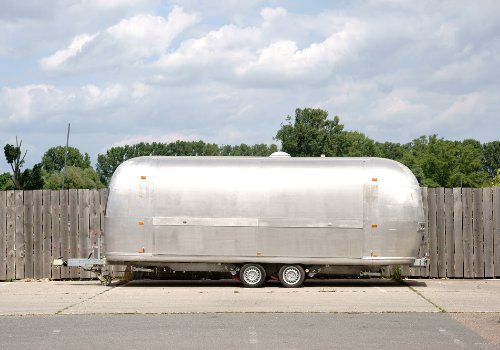
After World War II, manufacturers like Ford, Airstream, and Winnebago began mass-producing aircraft-style travel trailers, lowering the cost and enticing new RV shoppers.
The rounded shapes were futuristic and aerodynamic with durable construction, making them a hot seller. In addition, most camping trailers were wired for electricity and had running water.
Airstream was the first company to offer a fully contained travel trailer that includes an ice chest and stove, drawing rave reviews from women who preferred a less rustic camping experience.
Motorhomes of the 1940s had a more modern exterior design to replicate the look of the popular travel trailers, such as this custom woody built on a Chevy chassis (click to see a picture). Many designs have a full-height front end, similar to a Class A motorcoach, such as this 1941 Western Flyer.
Motorhome interiors also provide a stovetop, ice chest, and even a small room for a portable toilet and washing up.
Private campgrounds and “trailer parks” continue to grow, along with state and National park campsites. RV park amenities haven’t changed much during this decade, but families enjoy taking hikes, fishing, boating, and spending vacation time on more active outdoor entertainment.
RVs and Campgrounds During the 1950s
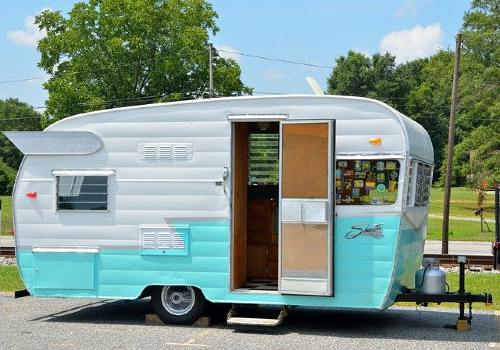
The 1950s ushered in a new phase of motorhome design, with Winnebago leading the way with RVs up to 30 feet long that include plumbing as a standard feature.
In 1952, Shasta travel trailers hit the market. Shasta Campers became an instant favorite for RVers, offering quality construction and models from 14 to 35 feet in length that were lightweight and easy to tow.
Niche manufacturers custom-built limited lines of amazing motorhomes, such as the Flxible Company, that took their bus chassis to bring motorcoach camping onto the scene. These RVs rival the amenities found in current recreational vehicles, such as separate bedrooms, full bathrooms and kitchens, and entertainment centers.
The 1950s campgrounds inside state and National parks remain about the same, with updates to bring power to the campsites at popular destinations.
Private RV parks during this time became a “home away from home,” as this camping video from the 1950s shows. New parks offer paved parking pads and patios, hookups for water, power, and often sewer, but also pack in the campsites to increase profits.
1950s USA Trailer Park Life (Video)
RV and Campground Features During the 1960s
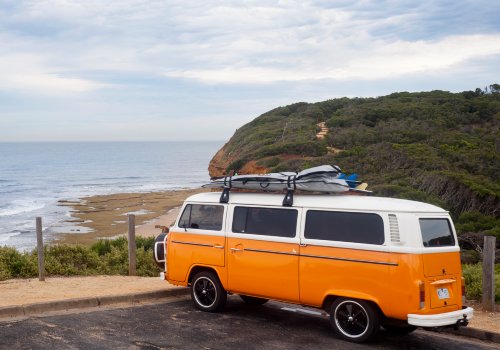
The 1960s brought in the mass introduction of the fifth-wheel trailer and conversion van, which gives RV shoppers more camping options. In 1964, the first “modern” pop-up trailers also made their debut.
The reason for RV brand and model expansion during this decade is the new interstate highway system, which makes it much easier for people to travel and explore more remote parts of the country.
The Volkswagen Westfalia van campers were a huge hit, with some models offering a fridge, electrical hookups, and a roof with a pop-up tent.
In 1968, Newell Coach revealed a new gas motorhome with high-end custom features to cater to customers who want a more luxurious camping experience, which ushers in the rise of Class A motorhome popularity with the well-to-do crowd.
Campgrounds and RV parks begin to alter campsites to fit larger recreational vehicles, and “seasonal” or “snowbird” parks pop up in more temperate US regions in the south and west.
In 1962, KOA campgrounds started in Billings, Montana, and will spread across the US and Canada in future decades.
In 1966, the Good Sam Club made its debut and quickly became the top RV club membership, which remains to this day.
RV and Campground Evolution During the 1970s
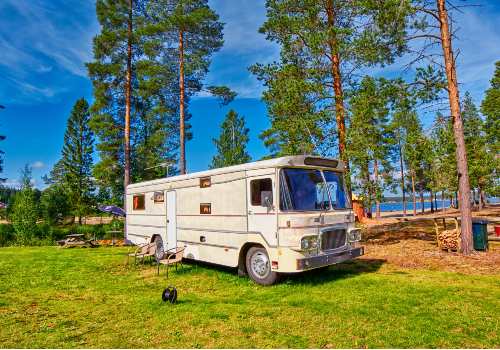
In 1970, the Newell Coach company put out the first rear-engine diesel pusher motorhome, changing the RV industry forever.
The ability of the engine to push more weight lets the builders safely install more interior and exterior amenities. In addition, the ride was much smoother and quieter with the diesel engine and better suspension.
GMC put out thousands of 26-foot-long front-wheel-drive motorhomes with the first air-bag suspensions. The fiberglass shell was sleek and curved, and two rear axles provided extra stability.
Most motorhomes of this time have complete kitchens, bathrooms, and sleeping space for up to eight with convertible dinettes, bunks, sofas, and separate bedrooms.
Travel trailers and fifth-wheels update their campers with the latest appliances, technology, and decor to attract new buyers.
The standard campsite from the 1970s didn’t change much, with a picnic table and a fire pit or grill. Many parking pads were still gravel, especially in the state or National park campgrounds, but newer RV parks began adding “deluxe” sites to attract the Class A motorcoach owner.
Bike riding became a “must-do” activity while camping, with RV bike racks a common sight.
Cars from the 70s were also more powerful, and many were able to work as tow vehicles for small travel trailers.
RVs and Campgrounds During the 1980s
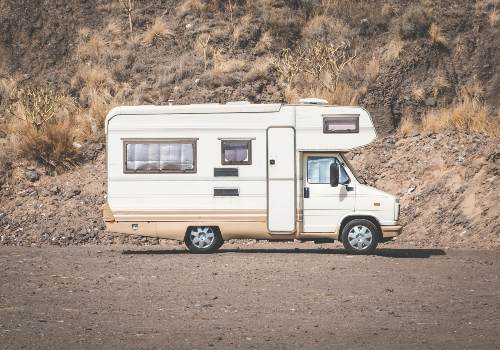
The 1980s recreational vehicles feature manual slide-outs, which create a more comfortable living space inside travel trailers, motorhomes, and fifth wheels.
Want to Connect With a Community of Over 1,078 RV Enthusiasts?
The Fleetwood Bounder is a top seller in the motorhome category, with all the latest bells and whistles for camping comfort.
Travel trailers and fifth wheels keep growing longer and heavier as heavy-duty trucks improve towing capacity.
RV park campsites maintain a basic appearance, with amenities like a swimming pool, sports courts, shower houses, clubhouse, bike or boat rentals, and camp store standard offerings.
Many private RV parks have begun paving parking pads to update their campsite appearance.
RV and Campground Biggest Updates During the 1990s
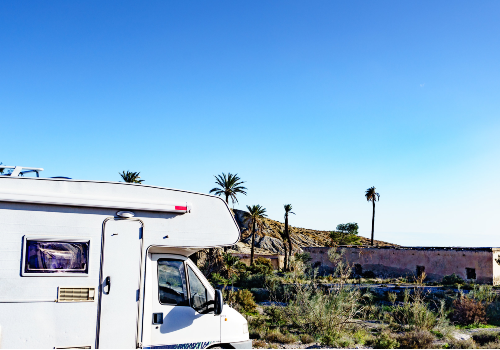
The Coachmen RV company rode high during the 1990s due to their highly popular Leprechaun Class C motorhome with a cab over bunk that increased sleeping capacity.
Travel trailer and fifth wheel features remain relatively stagnant, but the interior decor of the fifth wheel begins to move to a more luxurious level.
Power slide-outs are the latest feature that pushes RV sales, with more manufacturers offering one or two slides per model.
All types of larger RVs offer state-of-the-art dual propane and electricity appliances that include water heaters, furnaces, and refrigerators so campers can enjoy both on- and off-grid camping.
The proliferation of slide-outs on more RVs, in turn, makes private RV parks alter the spacing between campsites to accommodate the needs of guests. Broader sites prevent guests from complaining their neighbors’ slide is over their patio or trees impede the full use of their camper.
While state and National campgrounds remain the same, some expand some sites to fit larger RVs with slides to keep guests happy.
More and more private parks upgrade their amenities to become “destination” campgrounds, where guests have more activities and amenities. RV campgrounds with water parks, arts and crafts, lectures, 9-hole golf courses, restaurants and bars, propane filling, and more keep guests onsite and entertained during their vacation.
RVs and Campgrounds Through the 2000s
Motorhomes, travel trailers, and fifth-wheel designs from the 2000s don’t change much from the late 90s, with the major updates being in technology with more cameras, sensors, and GPS units standard.
Even small RVs and pop-ups offer wet baths, microwaves, cooktops, entertainment systems, and clever storage and sleeping options. Outdoor kitchens and TVs are more common as well.
Campgrounds and RV parks continue to make slight changes to keep up with customer demands, but overall, there are no significant differences to note.
RVs and Campground Changes During the 2010s

The 2010 decade is when there’s a big difference in modern RV design. Models feature numerous slide-outs (some up to five!), solar capability for boondock camping, internet and satellite connectivity, high-end appliances and entertainment systems, and interior design that feels much more residential.
More and more RV sales are for motorhomes and fifth-wheels in the 35 to 40-foot range, which pushes campgrounds to increase the depth of campsites to fit these longer campers.
Private RV parks find that becoming “exclusive” can boost their bottom line, with RV resorts that are strictly for Class A motorcoach owners popping up across the US. In addition, 55-and-over RV parks are another niche market that is growing by leaps and bounds.
Family-friendly campgrounds are another RV park segment rising during this decade. Families can find kid and adult-oriented activities to choose from, and higher noise levels and energy are accepted.
The range of activities at many parks is impressive, with classes ranging from guitar lessons to stained glass at large campgrounds.
On the flip side, boondocking and off-grid camping are rising in popularity as people try to escape the RVing crowds and increasing campsite fees.
RVs and Campgrounds in the 2020s
The 2020s have only just begun, but with the world health crisis still a part of everyday lives, the RV industry is at an all-time high for sales, and campgrounds and RV parks are full of people wanting a safer way to enjoy family vacation time.
While 45-foot RVs with all the comforts of home are hot sellers, so are tiny teardrop campers and pop-ups. DIY renovations of older RVs are another current trend for people on a budget looking to share in the fun of camping and RV travel.
Campgrounds keep updating campsites and amenities to remain current, but who knows what future changes will arise.
Final Thoughts
For over 100 years, the RV industry and community have continued to grow, with millions of Americans hitting the road each year to enjoy nature and commune with fellow camping enthusiasts.
I hope this peek into the history and changes of recreational vehicles over the decades was interesting and that you share it with others. Safe and happy travels!
History of Campers (Video)
"Man cannot discover new oceans unless he has the courage to lose sight of the shore."
-- Andre Gide

